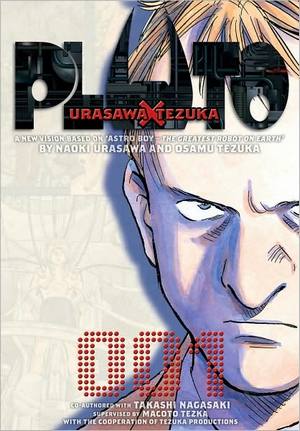- Comics
- Comics Reviews
- Manga
- Comics Reviews
- European Comics
- News
- Comics News
- Press Releases
- Columns
- Spotlight
- Digital Comics
- Webcomics
- Cult Favorite
- Back Issues
- Webcomics
- Movies
- Toys
- Store
- More
- About
By Leroy Douresseaux
February 10, 2009 - 14:43
 |
| Pluto 1 cover is courtesy of barnesandnoble.com. |
Rated “T+” for “Older Teen”
Renowned manga-ka Naoki Urasawa (Monster, 20th Century Boys) joined his creative vision to the work of legendary manga-ka, the late Osamu Tezuka, the “God of Manga” to create the manga, PLUTO.
In 1964, Tezuka presented the most famous story arc of his beloved manga, Tetsuwan Atom – which we know as Astro Boy. Entitled “The Greatest Robot on Earth,” this story apparently left an impact on readers, and according to Urasawa, this story was the first manga he ever read. With the permission of Tezuka’s estate, Urasawa created a new manga out of “The Greatest Robot on Earth,” with the focus now being on a supporting character from the original story, a very human-like, German robot detective named Gesicht. The title “Pluto” is the name of the story arc’s villain.
Pluto: Urasawa × Tezuka, Vol. 1 (collecting the first seven chapters of the story) begins with the discovery of a horrifying crime. Mont Blanc, the world’s most beloved robot, is found torn apart and killed in a burning section of the Swiss forest. Elsewhere, Bernard Lanke, a key figure in the movement to preserve robot laws, is found murdered in his wrecked apartment. Both victims have makeshift horns placed on their heads. Enter Europol Robot Detective Gesicht, who soon discovers that he may also be one of the targets.
THE LOWDOWN: A mystery and psychological thriller in the vein of his Monster, Pluto: Urasawa × Tezuka is another grand puzzle by Naoki Urasawa. Slowly and deliberately, Urasawa introduces a multitude of characters and subplots, each one adding motivations, secrets, conflicts, etc. to a complex and wide-ranging mystery that has its roots in the internal history of this narrative. Of course, the fictional world in which these characters live is familiar to them, but something frightening has shattered their normalcy.
Urasawa is also taking the readers into a brave new world. This is a seemingly, harmonious world of advanced robots, in which humans live side by side with machines that look so human – especially the melancholy Gesicht, whose demeanor suggests that he is both a determined lawdog and a gentle soul. The world is also new to the reader, and the reader must navigate this strangeness – trying to understand how one lives in such a world while trying to discover the mystery at the heart of the story. Most of all, as he did in monster, Urasawa, in this tale of artificial intelligence, is going to show us that what it means to be human can be many things.
POSSIBLE AUDIENCE: Readers will find that Pluto: Urasawa × Tezuka shares some similarities to Alan Moore and Dave Gibbons’ Watchmen, in particularly the way the protagonist/detective seeks to unravel a mystery.
A